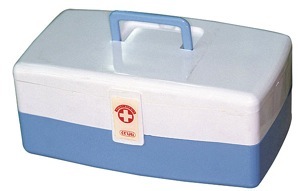-
Be Prepared for Disasters & Threats


For persons in the U.S., the chances of being the victim of a terrorist act or other life-threatening event is very slim compared to the many risky lifestyle behaviors they take part in. These include cigarette smoking, drinking too much alcohol, and reckless driving.
Even so, the fear of public health disasters and threats causes concern and alarm.
No one can promise absolute safety, but steps can be taken to be more prepared than scared of possible crises. The National Weather Service operates the most advanced weather and flood warning and forecast system in the world. This helps protect lives and property. The U.S. Government has increased measures to prevent attacks of terror. Airports, employers, schools, retailers, etc. are taking steps to prevent and be prepared for disasters of many kinds.
Plans to Make Before a Disaster
By acting on the items that follow, you and your family can be prepared for many types of disasters that can occur quickly and with little or no warning.
-
•Write down, ahead of time, the steps to take for different disasters (e.g., house fires, floods, etc.). Go through drills for each plan with the whole family. Make sure the car always has gas in case you have to leave an area.
-
•Know your place of work’s emergency plans. Find out about them from your supervisor, Employee Assistance Program (EAP), etc.
-
•Take a course in first aid from the Red Cross, your police or fire department, etc.
-
•Give each family member a prepaid phone card with about a ten dollar value. Instruct children how to use the card and a pay phone. Some cell phone services may be overwhelmed in a crisis.
-
•Set up a “check-in” plan. Choose someone for family members to call or e-mail to check on each other. Pick someone far enough away who would not likely be part of the same event. Of course, call each other on cell, regular, or pay phones.
-
•Choose two places to meet. One is at home or near your home. Choose another place farther away in case you can’t get home. Make plans for the safety of your children.
-
•If you have children in school, find out the school’s crisis plan. Know the school’s policy for sending children home. See that the school has current phone numbers for you and other caregivers (in case you can’t be reached). Find out what the school needs to have to release your child to assigned caregivers.
-
•If you have a pet, plan for its safety.
-
•When you enter a building, find emergency exits and stairways. Plan ahead how to get out quickly from buildings, vehicles, crowded public places, etc.
-
•Make an emergency supply kit. Put these things in backpacks or containers that one or more family members can easily carry:
-
-Three days’ supply of bottled water (one gallon a day per person if possible). Put these next to, not in, your backpack, etc.
-
-Food that won’t spoil. A hand can opener.
-
-Flashlight and extra batteries.
-
-A battery powered radio or TV and extra batteries.
Keep a first aid kit stocked and ready-to-go.

-
-First aid kits for the home and the car.
-
-Sleeping bags or blankets.
-
-A change of clothing for each person.
-
-Items for family members with special needs, such as baby supplies, medicines, etc.
-
-Duct tape and dry towels that you can make wet to make a room airtight.
-
-One small bottle of regular bleach (not scented). This may be needed to purify water. Use 2 drops of bleach per quart of water.
-
-Cash, credit cards, and important documents (or photocopies of them).
Web sites that give information on being ready for disasters are www.disasterrelief.org and www.redcross.org. {Note: Access these and other Web sites listed in this chapter as soon as you can. Don’t wait until a crisis occurs. You may not have time to do it then. You may not have electricity to run your home computer.}





Copyright © 2009, American Institute for Preventive Medicine. All rights reserved.